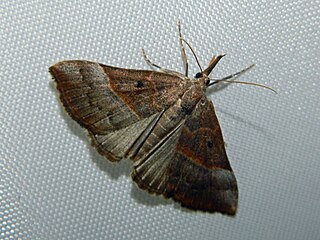
Lantana is a genus of about 150 species of perennial flowering plants in the verbena family, Verbenaceae. They are native to tropical regions of the Americas and Africa but exist as an introduced species in numerous areas, especially in the Australian-Pacific region, South and Northeastern part of India. The genus includes both herbaceous plants and shrubs growing to 0.5–2 m (1.6–6.6 ft) tall. Their common names are shrub verbenas or lantanas. The generic name originated in Late Latin, where it refers to the unrelated Viburnum lantana.

Hypena is a genus of moths in the family Erebidae. It was first described by Franz von Paula Schrank in 1802. These non-migratory moths overwinter as pupae and almost never estivate as adults.

Lantana camara is a species of flowering plant in the verbena family (Verbenaceae), native to the American tropics. It is a very adaptable species, which can inhabit a wide variety of ecosystems; once it has been introduced into a habitat it spreads rapidly; between 45ºN and 45ºS and less than 1,400 metres in altitude.

Hypena eductalis, commonly known as the red-footed snout, red-footed bomolocha moth, or alder smoke, is a species of moth in the family Noctuidae. The species was first described by Francis Walker in 1859. It is found in North America from Saskatchewan to Nova Scotia and south to Florida and Texas.

Sphenarches anisodactylus, commonly known as the geranium plume moth, is a species of moth in the family Pterophoridae. It is found in western Africa, Madagascar, India, Sri Lanka, Thailand, Japan, the New Hebrides and Central and South America, as well as Australia, where it has been recorded from Cape York to central New South Wales. It is found in the United States, where it has been recorded from Florida, as well as Mississippi. It is also present in the Kermadec Islands of New Zealand.

Lantanophaga pusillidactyla, the lantana plume moth, is a moth of the family Pterophoridae. It is native to the southern United States, Mexico, the Caribbean, and South America.

Strymon bazochii, the lantana scrub-hairstreak or smaller lantana butterfly, is a butterfly in the family Lycaenidae. It is found from Paraguay north through Central America, the West Indies and Mexico to southern Texas. It was introduced to Hawaii in 1902 to control Lantana species, in which it has proven unsuccessful.
Diastema tigris, the lantana moth or lantana control moth, is a moth of the family Noctuidae. The species was first described by Achille Guenée in 1852. It is endemic to the US states of Florida and Texas, but has been introduced in Zambia, Australia, Micronesia, Fiji, Hawaii, Ghana, St. Helena, Tanzania, Uganda and Mauritius. as biological control of Lantana camara.

Hypena obacerralis is a moth of the family Erebidae. It is found throughout Africa, the Middle East and South Asia and Malaysia.

Aconophora compressa is a species of insect in the treehopper family, Membracidae. It is known by the common names lantana bug, lantana treehopper, lantana stemsucking treehopper, and lantana sap-sucking bug.
Hypena abyssinialis, the streaked snout, is a moth of the family Erebidae. The species was first described by Achille Guenée in 1854. It is found in many African and South Asian countries.
Hypena mandatalis, is a moth of the family Erebidae first described by Francis Walker in 1859. It is found in the Indian subregion, Pakistan, Sri Lanka, Borneo, Sulawesi and Australia.










